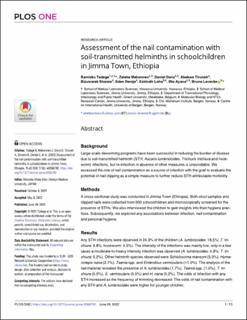| dc.contributor.author | Tadege, Bamlaku | |
| dc.contributor.author | Mekonnen, Zeleke | |
| dc.contributor.author | Dana, Daniel | |
| dc.contributor.author | Tiruneh, Abebaw | |
| dc.contributor.author | Sharew, Bizuwarek | |
| dc.contributor.author | Dereje, Eden | |
| dc.contributor.author | Loha, Eskindir | |
| dc.contributor.author | Ayana, Mio | |
| dc.contributor.author | Levecke, Bruno | |
| dc.date.accessioned | 2022-06-30T16:37:09Z | |
| dc.date.issued | 2022-06-01 | |
| dc.identifier | oai:www.cmi.no:8381 | |
| dc.identifier.citation | in PLoS ONE vol. 17 no. 6 e0268792 p. | |
| dc.identifier.issn | 1932-6203 | |
| dc.identifier.uri | https://hdl.handle.net/11250/3001838 | |
| dc.description.abstract | Background
Large-scale deworming programs have been successful in reducing the burden of disease due to soil-transmitted helminth (STH; Ascaris lumbricloides , Trichuris trichiura and hookworm) infections, but re-infection in absence of other measures is unavoidable. We assessed the role of nail contamination as a source of infection with the goal to evaluate the potential of nail clipping as a simple measure to further reduce STH-attributable morbidity.
Methods
A cross-sectional study was conducted in Jimma Town (Ethiopia). Both stool samples and clipped nails were collected from 600 schoolchildren and microscopically screened for the presence of STHs. We also interviewed the children to gain insights into their hygiene practices. Subsequently, we explored any associations between infection, nail contamination and personal hygiene.
Results
Any STH infections were observed in 24.3% of the children ( A . lumbricoides : 18.5%; T . trichiura : 9.8%; hookworm: 0.5%). The intensity of the infections was mainly low, only in a few cases a moderate-to-heavy intensity infection was observed ( A . lumbricoides : 4.3%; T . trichiura : 0.2%). Other helminth species observed were Schistosoma mansoni (5.0%), Hymenolepis nana (2.7%), Taenia spp. and Enterobius vermicularis (<1.0%). The analysis of the nail material revealed the presence of A . lumbricoides (1.7%), Taenia spp. (1.0%), T . trichiura (0.5%), E . vermicularis (0.5%) and H . nana (0.2%). The odds of infection with any STH increased as the frequency of trimming decreased. The odds of nail contamination with any STH and A . lumbricoides were higher for younger children.
Conclusions
The presence of helminth eg | |
| dc.language.iso | eng | |
| dc.relation | PLoS ONE | |
| dc.relation | 6 | |
| dc.relation.ispartof | PLoS ONE | |
| dc.relation.ispartofseries | PLoS ONE vol. 17 no. 6 | |
| dc.relation.ispartofseries | PLoS ONE vol. 17 no. 6 | |
| dc.relation.uri | https://www.cmi.no/publications/8381-assessment-of-the-nail-contamination-with-soil-transmitted-helminths-in-schoolchildren-in-jimma-town | |
| dc.title | Assessment of the nail contamination with soil-transmitted helminths in schoolchildren in Jimma Town, Ethiopia | |
| dc.type | Journal article | |
| dc.type | Peer reviewed | |
| dc.identifier.doi | 10.1371/journal.pone.0268792 | |
| dc.identifier.doi | 10.1371/journal.pone.0268792 | |
